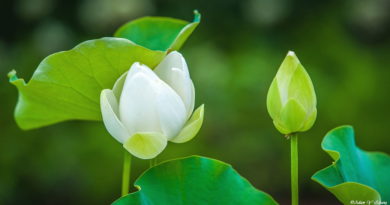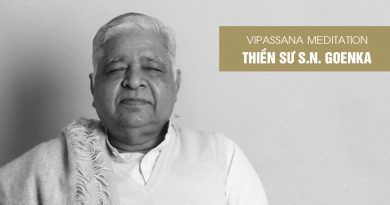Discourse At The Presentation Of The First Volumes Of Tipitaka In Devanagari Script
(The following discourse was given by Mr. S. N. Goenka as a closing address at the seminar titles ‘Vipassana: Its Relevance to the Present World” and at Presentation of the first Volumes of Tipitaka in Devanagari script)
Venerable Bhikkhu Sangha and friends on the path of Dhamma, the path of liberation from all the miseries of life:
What is Dhamma? It is not an organized religion. It has nothing to do with any lifeless rites or rituals, or with the intellectual games of philosophers. Dhamma is a way of life, an art of living. It teaches us how to live peacefully and harmoniously within, and how to generate only peace and harmony for others. It cannot be restricted to a particular organized religion or to a particular country; it is for everyone. Everyone is suffering.
At Vipassana courses in prisons we find that the inmates are very miserable. But it is the same outside, because everyone is a prisoner. We are all prisoners of our own mental behaviour patterns, constantly generating negativities in our minds and suffering as a result. How can we free ourselves from these negativities? Dhamma, universal Dhamma, is the way.
It is unfortunate that we have made Dhamma, or dharma, sectarian. Since I first came to India about twenty-five years back and started to conduct Vipassana courses and give talks about Vipassana, I have used the word “Dhamma.” I always explain that this means dharma. The moment I use the word dharma, people wonder which dharma I teach. Is it Hindu dharma, Buddhist dharma, Jain dharma, Muslim dharma, or Christian dharma? As if dharma by itself has no existence at all!
Pure Dhamma does not require these crutches, these supports. Hindu dharma is limited to people who call themselves Hindu. It is the same with Jain, Buddhist, Muslim, Christian, Sikh, Parsi, or Jewish dharma. They are all limited. But Dhamma is unlimited, infinite.
Here in India, this sectarian interpretation of dharma has existed for the past two thousand years. I am told by scholars that before this period, such words as “Hindu dharma” were never used in any of the ancient literature. Buddha only used the word “Dhamma”; he never said Bauddha-dharma. For those who started following his teaching and practising Dhamma, he used words such as dhammiko, dhammattho.
Dhamma is great. It governs the entire universe, animate and inanimate. Dhamma is the law of nature. It is said that “the dhamma or dharma of fire is to burn.” This means that the quality-the characteristic, the nature-of fire is to burn. If I place my hand into fire, the fire will burn my hand. Whether I call myself a Hindu, a Muslim or a Buddhist; whether I am a Brahmin or a shhudra (low caste), an Indian, an American or a Pakistani-it makes no difference whatsoever. The fire does not discriminate. It burns, because this is the nature of fire. This is the dhamma of fire.
In the same way, the Dhamma of our mental impurities burn us, making us miserable. The Buddha, the Enlightened One, discovered this universal law of Dhamma: if someone generates a negativity or impurity in the mind (such as anger, hatred, ill-will, animosity, ego, craving, passion, or fear), the law of nature is that this person will be punished, then and there. Through the practice of Vipassana we can start observing how the fires of negativity arise and how we are burned by them, making ourselves miserable. When we go deep inside, we start experiencing this reality.
Sabbo pajjalito loko, sabbo loko pakampito, pakampito
-The entire world is burning, the entire world is vibrating, vibrating.
This is what the Enlightened One realized. He found that the entire physical structure, the entire mental structure, and the combination of the two, is nothing but vibration.
Suppose we try to investigate what is “I” or what is “mine.” Is this physical structure which I call “I” and “mine” really “I”, really “mine”? And this mental structure which I call “I” or “mine”-is it really “I”? Is it really “mine”? If it is indeed “mine,” then I should have control over it. Yet I have no mastery over it at all. Things just happen naturally, due to the universal law of cause and effect.
At the experiential level, when we start understanding the law of nature within ourselves, we find that the moment we generate any negativity in the mind, there is a vibration which makes us unhappy and agitated. It may be a vibration of anger, hatred, ill-will, animosity, passion or craving; all will make us unhappy.
The Buddha was a “super-scientist” who discovered the truth of the interrelation and interaction of mind and matter, and how they result in continuous currents, cross-currents, and under- currents. He discovered how mind influences matter, and how matter influences mind. Benefiting from his profound discovery, let us try to understand the cause of suffering.
Suffering is not caused by outside objects; they are only the apparent reason. Whatever we experience in life is encountered through our six sense doors. A shape or form may come to the eyes; a sound may come to the ears; a smell may come to the nose; a taste may come to the tongue; something tangible may come in contact with the body; or a thought may come to the mind.
These are the six sense doors and their six respective sense objects. When they come into contact, a sensation immediately starts in the body. It is either pleasant or unpleasant, according to the evaluation we have given to the object outside.
If the sensation is pleasant, we start reacting with craving. If the sensation is unpleasant, we start reacting with aversion. This is what the words of the Enlightened One-vedana-paccaya tanha (with the base of sensation, craving and aversion arise)-refer to. It only appears that our reaction is to the outside object; in actuality, we are reacting to the sensation. The missing link that was discovered by this wonderful person was vedana, the sensation on the body. If we are ignorant of this, then we direct all of our efforts to rectifying things outside ourselves. We don’t rectify the things inside, and these are the root causes of our misery.
Suppose you are a good Vipassana meditator and someone has abused you. You will not react. Your attitude will be: “If this person has abused me, why should I react and generate negativity? This person must be very miserable. No one can be abusive without generating a tremendous amount of anger in his mind. Such a person is sick or ignorant, making himself miserable. He doesn’t know what he is doing. He is harming himself, burning himself.”
An experienced meditator will not feel like throwing more fuel-the fuel of anger and hatred-onto this burning fire. Instead, he or she will want to throw the cool water of love and compassion. In the same way, a mother always has love and compassion for a child with a high fever. In his delirium, a child may be shouting abusively, perhaps even at the mother. But the mother does not shout in return; she is filled with love and compassion. Vipassana takes us to that stage, where we can have love and compassion in all situations. Of course it takes time, but that is the ideal way of life, and it is attainable by every person. This is what the Enlightened One taught: a way of life, an art of living. He did not try to convert people from one organized religion to another. Nothing is gained by that.
This seminar has been sponsored by the Vipassana Research Institute, which has undertaken different aspects of study. It is publishing the scriptures and conducting research on the effects of Vipassana on people from different walks of society. All this is useful. It gives some understanding at the intellectual level. This research work is helpful if we understand Dhamma in the proper perspective, and not as Hindu dharma, Buddhist dharma, Jain dharma or Christian dharma. We should try to understand the law of nature, which does not discriminate, and does not favour anyone.
Every individual has to do one’s own research on the law of nature within, the Dhamma within. Without this research, we cannot benefit from Vipassana. Siddhattha Gotama did wonderful research, by which he understood the law of nature. Through this understanding, his entire mental structure started changing and became purified; it became ultra-pure. He became an enlightened person. However, his research allowed only one person to become enlightened, and that was Siddhattha Gotama. He became a Buddha, a fully enlightened one. He was liberated from all his miseries.
A Buddha can only show the path to others. You have to work for your own salvation, for your own liberation. No one else can liberate you. Every person must realize this truth. You alone are responsible for generating all your mental impurities.
When we pray to some invisible power-“Oh, please liberate me!”-what have we started doing? I know from my own experience, because I was following such a path for many years. I was born into a conservative Hindu family and starting from my childhood days, I was fascinated by the Gita and Upanishads. I was always pondering how to reach the high stages of wisdom mentioned in the Gita, but they were beyond my reach. I was a bundle of ego and anger. I was so miserable, and I made everyone around me miserable as well.
Sometimes in my misery, I would repent and cry, thinking: “I frequently recite from the Gita and the Upanishads, their wonderful ideals that we should come out of all mental impurities and that we should get established in wisdom. But how can I do this?” There seemed to be no way. I could only contemplate: “Oh, raga (craving) is very bad! I must become vita-raga, (free from craving). Dvesha, aversion, is very bad! I must become vita-dvesha.” But all this was merely an intellectual exercise.
At other times I was caught in an emotional game: “O God Almighty, please relieve me from my misery; please purify my mind. Take away all these cravings and aversions!” Yet I could not get rid of a trace of impurity; my life was very miserable.
It was some great good fortune that brought me into contact with my teacher, Sayagyi U Ba Khin. I feel very fortunate to have learned Vipassana from him. When I took my first course of Vipassana, I was so fascinated by the technique. After practising for four days, I realized that Vipassana is applied Gita. For years, I had been giving orations about this vita-raga, vita-dvesha-how we must rid ourselves of craving and aversion-but I had no way to achieve this, no way to practice. During this first Vipassana course, it became so clear to me: what causes our misery, how this misery multiplies, and how we can liberate ourselves from it. I certainly did not become free from all suffering in those ten days, but they were wonderful days for me. I had found the Path. I had found the light.
Down through the ages, the saints of India have given importance to the truth that we experience: “Kima sachiyara hoviye “
We must remain with the truth that we ourselves experience, not the truth experienced by somebody else. We must start with the truth and remain with the truth, until we reach the ultimate truth. If we start with any kind of imagination and continue with imagination, we will end up with further imagination. No imaginary beliefs, dogmas, theories or philosophies should be imposed on the truth.
Five centuries after the time of the Buddha, India had lost the scientific method of Vipassana. But fortunately, the words of the Enlightened One, and the practice, were maintained in the neighbouring country. I feel very fortunate when I think of the seven decades of my life. I was very fortunate to be born in a wonderful country, a Dhamma country-the neighbouring country of Myanmar, where my grandfather had settled. My teacher, Sayagyi U Ba Khin, was a traditional teacher who learned Vipassana from his teacher. Sayagyi, my Dhamma father, taught me this wonderful technique. After having experienced its profound benefits myself, I started bringing many Indian friends to Vipassana courses. I found that they all benefited. Whoever practises this technique is gradually freed of mental and physical misery.
The technique was preserved in pristine purity in Myanmar, even though the land of my forefathers had lost it. My teacher Sayagyi was so compassionate. He said: “The teaching has come from India. Myanmar has a debt to India. We must pay back this debt of gratitude.” He was very eager to come to this country, to bring this wonderful technique and offer it to the people here, but various hindrances prevented him from coming.When I had the opportunity to come to India, he was very happy. He said: “You will pay back the debt of gratitude to the country where this wonderful jewel of Dhamma originated.” I was also very happy. Nowadays non-resident Indians [N.R.I.s] returning to their homeland, bring a lot of valuable foreign exchange. When I came to India, I did not bring any foreign exchange because my motherland did not have any to give me. But this N.R.I. brought an invaluable jewel!
This jewel is yours. It originated in this country. Make use of it, not to oblige others or to be converted into any organized religion. If you are a Hindu, keep calling yourself a Hindu. If you are a Muslim, keep calling yourself a Muslim. Or a Christian, a Sikh, a Jew, a Buddhist, a Parsi. The nomenclature makes no difference. Be a good Hindu. Be a good Muslim. Be a good Buddhist. Be a good Christian. If one is not a good human being, how can one be a good member of one’s faith or community?
Dhamma teaches us to become good human beings. I am very happy that people who come to Vipassana courses are converted, but not from one organized religion to another organized religion. They are converted from misery to happiness! They are converted from bondage to liberation. They are converted from ignorance to wisdom.Experience this conversion-for your own good, for the good of everyone in this country, for the good of all humanity. Be freed from these sectarian bondages, philosophical bondages and blind beliefs. See the truth as it is and make use of this truth. See the law of nature as it is and make use of it.
Presentation of the Tipitaka volumes
When I came to this country, I was fortunate to bring back an invaluable Indian heritage.
Siddhattha Gotama was born in the wonderful country of Nepal. He became enlightened in the wonderful country of India. Nepalcould not keep him within its boundaries and neither could India. He was here for the entire world, so his message started spreading. People in southeast Asia-in Sri Lanka, Burma, Thailand, Cambodia, Laos-maintained his words in their pure form. From teacher to pupil, the words were preserved by memorization and recitation. Even a few years ago, in my motherland, in Myanmar, there was a very learned monk who knew the entire Tipitaka by heart, some fourteen to fifteen thousand pages. All the scriptures were maintained by this tradition of recitation.
During all these countries, the literature remained uncontaminated. At the Chattha Sangayana (Sixth Council) in Myanmar in 1954-56, many scholars from all the neighbouring countries met and recited the scriptures, the words of Buddha. Different countries have different scripts and the pronunciations differ, but Pali is Pali: the words are the same. When the scholars and monks started reciting the vast Tipitaka, there were only a few discrepancies here and there, such as spelling mistakes or other minor errors. Otherwise the words of the Buddha had remained the same for centuries. The teachings had gone to these countries and had been kept in their pristine purity. In Myanmar, the entire Tipitaka was preserved-about fifteen thousand pages-plus the commentaries and subcommentaries: in all about fifty or sixty thousand pages.So, about twenty-five years ago, not only was the technique of Vipassana, the patipatti (practice) brought back to this country, but the entire Dhamma literature. The people of my motherland offered it to me and I brought it to India. Now it is being transcribed in Devanagari script. India has lost this literature, so it should be available to this country in Devanagari, the script that people here can read. Of course the capacity is there to convert it into different scripts, and it will be converted, printed and published in other scripts, but we are starting with Devanagari.
Although the Vipassana Research Institute has undertaken this project, it is assuredly a joint venture of Myanmar and India. A number of Pali scholars are helping here in India, and a larger number of Pali scholars are helping in Myanmar. When we transcribe from the Burmese script to Devanagari, we send it to them and they check it for accuracy. So it is a joint enterprise, a wonderful offering to the entire world by both Myanmar and India. As a beginning, the first published eleven volumes will now be presented to the representatives of the different countries who have come here for this purpose. This should be done jointly. So I would like to say “Tamagyi cwaba”.
I respectfully request the Ambassador from Myanmar, U Winn Lwin, to come and join us in offering this wonderful Dhamma, the pariyatti Dhamma, to the representatives from India, Myanmar, Sri Lanka, Nepal and Thailand.
Source: https://www.vridhamma.org





